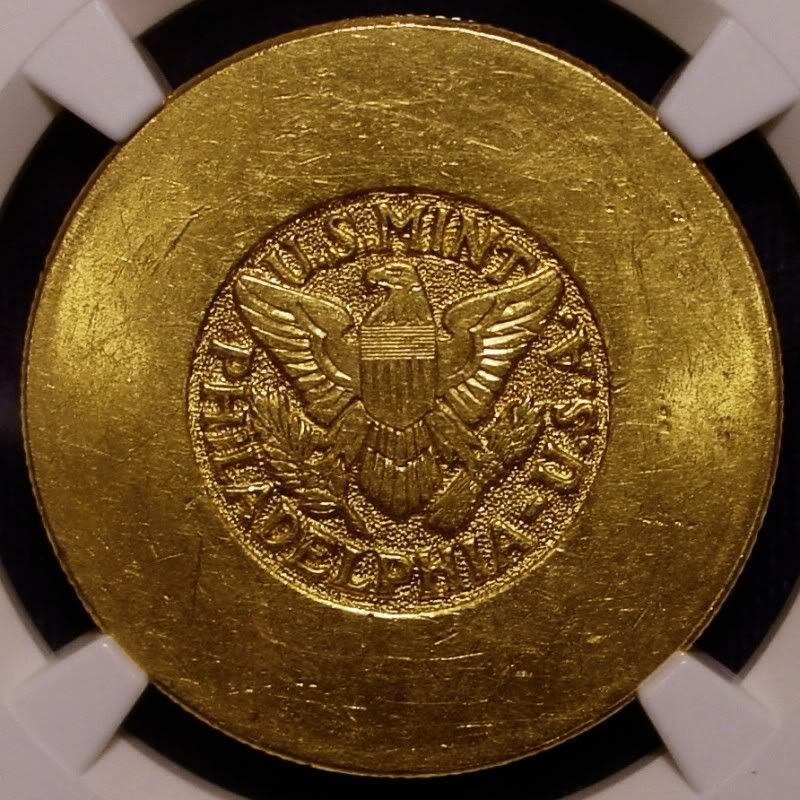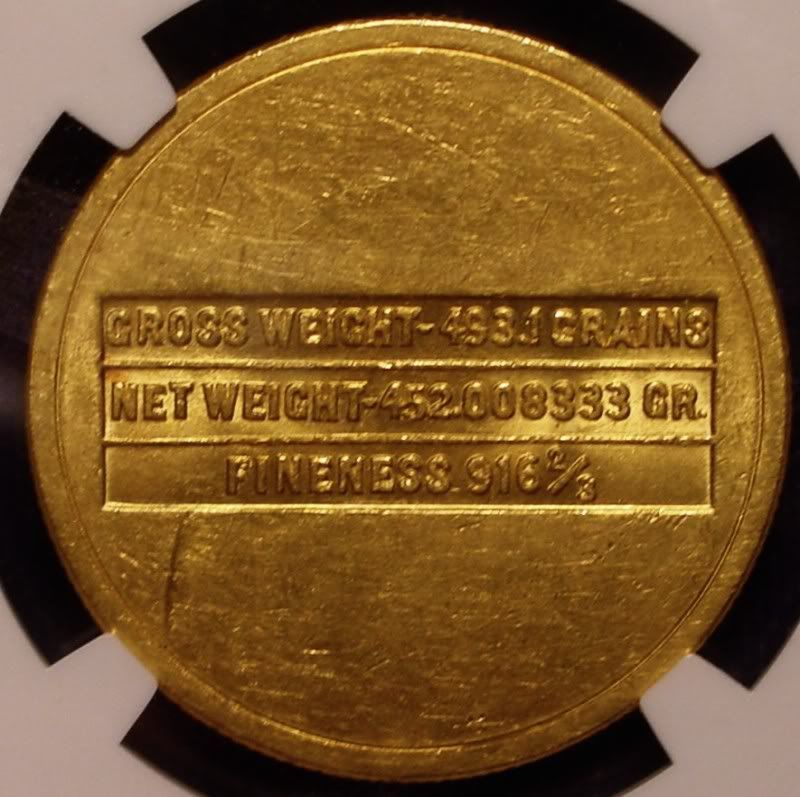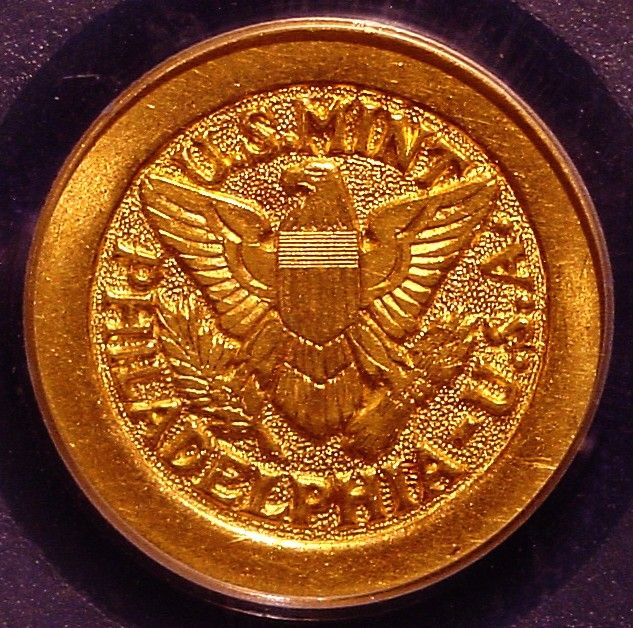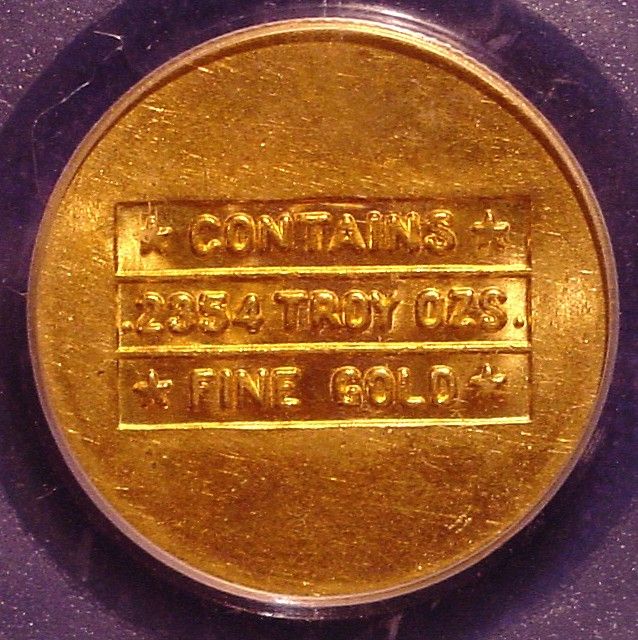The American Gold Sovereigns
The American Gold Sovereign
By Bill Jones
In 1933 President Franklin Roosevelt issued his Gold Surrender. The order required American citizens to sell all but a small portion of their gold to the Federal Reserve at a rate of $20.67 per troy ounce. Those who failed to comply with this executive order were subject to a fine of up to $10,000 or a prison term of up to 10 years. Exemptions were made for "customary usage for industry, profession or art," which covered artists, jewelers, dentists, and sign makers among others. There was also a provision for citizens to hold up to $100 in gold (about 5 ounces) and for "gold coins having recognized special value to collectors of rare and unusual coins."
Given the broad sweep of this executive order, which was supported by an act of Congress in 1934, you might assume that The United States mint did not produce any gold pieces for an American company until the restrictions were lifted in 1974. Interestingly there were exceptions, and the first one occurred in 1945, only a dozen years after the order was put into effect. As you might expect national security and the health of the American economy were involved.
Saudi Arabian Oil
In 1932 the Bahrain Petroleum Company, which was a subsidiary of Standard Oil of California (SoCal, now known as Chevron), discovered petroleum on the island of Bahrain, which is east of Saudi Arabia. This discovery heightened speculation that there were also petroleum reserves on the Saudi mainland. The Saudi government accepted a proposal from SoCal over a rival bid from the Iraq Petroleum Company, and SoCal formed a wholly owned subsidiary, California-Arabian Standard Oil (CASOC) to search for it.
By 1936 CASOC had not found any oil, and chose to sell 50% of its interest in the venture to Texaco. Finally in 1938 oil was discovered and production expanded rapidly. During the Second World War Saudi Arabia would become a strategic source for petroleum in the war effort, which made a continuing flow of petroleum products vital to the Allied cause. In 1944 the California-Arabian Standard Oil changed its name to the Arabian American Oil Company or Aramco for short.
The contract between Aramco and the Saudi government called for a royalty payment of $3 million a year in gold. During the wartime period the Saudi government had accepted this payment in U.S. dollars, but that changed in 1945. By then wartime pressures on the world economy had pushed gold prices to $70 an ounce in some markets. This sharp deviation from the official American price of $35 prompted the Saudis to demand gold for their royalty payment. Aramco and more importantly, the U.S. Government faced the possibility of losing a vital source of oil if the Saudi demands were not met.
In response the U.S. Government agreed to supply gold pieces to Aramco to pay their debt. The gold pieces, which were defined as gold disks and not coins, were made at the Philadelphia mint. Aramco was responsible for paying for the gold and the production costs. The pieces featured a U.S. heraldic eagle in the center surrounded by "U.S. MINT ... PHILADELPHIA-U.S.A." This design appeared in the middle of plain, wide field, and the edges were reeded. John Sinnock, who designed the Roosevelt dime and the Franklin half dollar, took credit for the art work although it was really an application of a stamp that the mint used on official U.S. gold bars. The reverse read in three lines: "GROSS WEIGHT 493.1 GRAINS" / "NET WEIGHT (in gold) 452.008333 GR." / "FINENESS 9162/3." The piece weighed just over an ounce and contained .941 of an ounce of pure gold. In international terms the fineness and gold content were equal to four British gold sovereigns. The mintage was 91,210.


Most of these pieces no longer exist today. Large numbers of them were crated and shipped to Bombay, India where they were sold for $70 an ounce, double the official U.S. rate. Most of these pieces were melted, turned in gold bars and shipped to Macao, a Chinese territory. There were rumors that some pieces ended up in the American compound in Saudi Arabia where oil company employees used them as poker chips. Some numismatic researchers have discounted this story, however.
In 1947 Aramco once again needed gold pieces to pay the Saudi royalty. This time the U.S. mint struck 121,364 smaller gold disks with a similar design. These pieces featured the same gold eagle stamp on the obverse that had been used on the 1945 issues. The reverse read, "* CONTAINS * / .2354 TROY OZS. / * FINE GOLD *." These coins contained the same amount of gold as the British gold sovereign Those coins actually saw some popular use in Saudi Arabia and traded for about $12, or 40 silver Saudi riyals. Their popularity declined, however, when Swiss and Lebanese counterfeiters began striking similar pieces that had a lower gold content. After that the Saudis melted many of the remaining large and small American gold disks, and reused the bullion to produce their own gold sovereigns.


Today only a small supply of these unusual American gold pieces survives. Interested collectors should be very careful because many counterfeits have been produced and the purchase of certified pieces is highly recommended. NGC has graded 205 examples of the large gold disk with the highest grade assigned at MS-63 and 81 examples of the small gold disk with the highest grade pegged at MS-65. PCGS has graded 41 large pieces with the highest grade listed as an MS-63, and 19 examples of the small gold disk with the highest graded piece assigned rated as an MS-64.
These pieces are seen occasionally at the shows and in coin shops. The larger, four sovereign piece, is offered more often, but the prices for both varieties are similar. Although the larger piece contains four times as much gold, the small piece is scarcer. A search of the Internet reveals that dealers who specialize in foreign coins are most likely to have one of both of these pieces in stock.
Comments
``https://ebay.us/m/KxolR5
Much appreciated.
would be a cool set
There are only two pieces in it. Oddly enough these pieces are not coins. It was illegal for U.S. citizens to own them until the gold restrictions were removed in 1974.
All I can add to Bill's writing, and he already said it, is that
the counterfeits of these two gold discs are VERY deceptive
and difficult to determine authenticity.
Tom
TD
has great history too... Thanks again, Cheers, RickO
New collectors, please educate yourself before spending money on coins; there are people who believe that using numismatic knowledge to rip the naïve is what this hobby is all about.
I've handled these back in the 1970's and 80's, both sizes.
All I can add to Bill's writing, and he already said it, is that
the counterfeits of these two gold discs are VERY deceptive
and difficult to determine authenticity.
I've examined genuine and reproduction examples side-by-side.
I think they are fairly easy to identify if you know what to look for.
The stippling in the background has a sharper texture on the genuine pieces.
The reproductions have a rounded less-sharp profile to the stippling.
Complete Set of Chopmarked Trade Dollars
Carson City Silver Dollars Complete 1870-1893http://www.pcgs.com/setregistry/showcase.aspx?sc=2722"
But with your presentation maybe I'll keep an eye out and maybe buy one.
You've provided an interesting history.
In the 70's it was Henry Kissinger who invented the Petro-Dollar linking oil to the USD and still today oil is traded in dollars.
I've handled these back in the 1970's and 80's, both sizes.
All I can add to Bill's writing, and he already said it, is that
the counterfeits of these two gold discs are VERY deceptive
and difficult to determine authenticity.
I've examined genuine and reproduction examples side-by-side.
I think they are fairly easy to identify if you know what to look for.
The stippling in the background has a sharper texture on the genuine pieces.
The reproductions have a rounded less-sharp profile to the stippling.
When I was authenticating I was never comfortable ruling as to authenticity on any of these, and always sent them out to a consultant.
One thing I could never pin down was whether any sort of a hub was used to make the original dies, or if Sinnock just stippled each one by hand, leaving different stippling on each die. I still don't know.
Perhaps Bill could show pictures of each die in the article I hope he does for The Numismatist.
TD
Jeff
The Mysterious Egyptian Magic Coin
Coins in Movies
Coins on Television
Their popularity declined, however, when Swiss and Lebanese counterfeiters began striking similar pieces that had a lower gold content. After that the Saudis melted many of the remaining large and small American gold disks, and reused the bullion to produce their own gold sovereigns.
Too bad these were counterfeited by the Swiss and Lebanese. Seems like being NCLT with a face value would make coins easier to protect than gold medals without legal tender value.
BTW, these look very cool with a great history. Thanks for the write up, it's top notch!